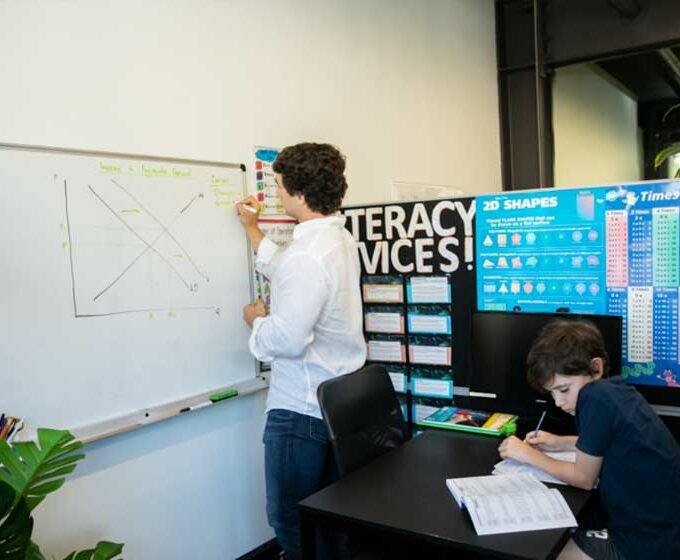In the ever-evolving landscape of education, the shift towards virtual learning has become more than a mere trend—it’s a transformative force shaping the way we teach and learn. As the world becomes increasingly interconnected, the demand for effective virtual English teaching has never been higher.
The ability to seamlessly impart language skills through digital platforms has become a crucial skill for educators, opening up new avenues for learning and communication. For this, it is important to fully understand what virtual English teaching is all about and its unique challenges and opportunities.
Understanding the Virtual Classroom
Understanding the virtual classroom is the first step in the roadmap to successful virtual English teaching.
Unlike traditional English teaching, the virtual classroom has no physical boundaries and can connect students and teachers from various locations around the world. Online English teaching relies heavily on digital communication tools, challenging teachers to recreate the human connections that are important to effective language learning. However the absence of physical presence can affect the immediacy of feedback, potentially influencing the learning process.
Virtual English teaching brings exciting opportunities, including the ability to be creative with multimedia, foster global collaboration, and adapt lessons to individual learning styles. Navigating the virtual classroom requires teachers to embrace technology, rethink traditional teaching methods, and remain adaptable in the face of both challenges and opportunities.
Tools and Setup
The success of virtual English teaching relies heavily on the thoughtful selection of tools and a well-organized setup. The essential tools for virtual teaching, on matter which subject, include reliable video conferencing platforms such as Zoom or Microsoft Teams. These platforms will facilitate real-team communication and interaction between teacher and student.
A Learning Management System (LMS) is crucial for organizing and delivering course materials, assignments, and assessments. Examples are interactive whiteboards and document cameras. These tools can simulate a traditional classroom experience and enable dynamic presentations and real-time annotations. Next to that, digital collaboration tools like Google Workspace and Microsoft Office 365 fosters group work and participation between students.
On the practical side, you need a reliable internet connection. It is also not a bad idea to have a backup plan in case of technical issues. To provide a most optimal experience for your students, invest in good quality audio and video equipment. For yourself, an ergonomic setup and organized workspace contributes to a professional teaching atmosphere and your own comfort.
Designing Engaging and Interactive Content
As mentioned before, online teaching requires a different format than teaching in a traditional classroom. While the intrinsic content of online teaching is the same, the way in how this content is delivered to students is vastly different and relies heavily on digital multimedia elements.
The integration of interactive activities, games, and real-world examples enhances engagement, while continuous assessment and feedback mechanisms through digital tools contribute to a responsive teaching approach. Kahoot! And Quizizz are excellent online quiz and game platforms, and Duolingo can encourage students to continue their learning outside of the classroom.
Edpuzzles embeds questions, quizzes and discussions into videos to ensure active viewing from students. Mentimeter can create live polls, quizzes, and interactive presentations. A tool especially handy for English language learning is Storybird, which encourages creativity and engagement by allowing students to create and share digital stories.
The most important factor in designing engaging and interactive content is your ability as a teacher to imagine your students’ minds and what they need to stay engaged and motivated. Tools and apps can certainly help, but it is the way in which you tell a story and convey content is what keeps your students interested in learning more and training their own abilities.
Student Engagement and Motivation
In the realm of virtual English teaching, success hinges on the art of kindling student engagement and motivation in a digital landscape.
Effectively navigating this terrain requires educators to skillfully leverage technology as both a medium and a message, employing interactive platforms, multimedia resources, and collaborative applications to transcend the limitations of physical spaces. By integrating these tools, educators can infuse the English learning experience with dynamism and interactivity, catering to diverse learning styles and keeping students actively involved in the virtual classroom.
Beyond the technological realm, cultivating a sense of community among students is equally essential. Establishing supportive virtual environments through discussion forums, collaborative projects, and language exchange programs fosters a connection among students, encouraging active participation and enhancing the overall success of learning English in a virtual classroom.
Common Challenges
Teaching English online presents a myriad of challenges for teachers, ranging from technological hurdles to maintaining student engagement in the digital realm.
One common obstacle is the potential for technological glitches and connectivity issues. To overcome this, teachers should familiarize themselves with the chosen platform, conduct technology checks before classes, and have backup plans for alternative communication channels. You don’t need to be an IT wizard to give online lessons, but it is recommended to have some understanding of the technology you are using.
Another challenge is the potential for student disengagement due to the distractions inherent in remote learning environments. Teachers can combat this by incorporating interactive elements, fostering a sense of community through virtual discussions, and varying instructional methods to keep students actively involved.
One challenge that is often overlooked is the potential for feelings of isolation among students. Establishing open communication channels, offering virtual office hours, and creating collaborative projects can help build a supportive virtual community. Teaching in a traditional classroom can become pillars of support for students, and there is no reason why you shouldn’t be able to do the same in an online classroom, provided that you adapt your teaching methods and interpersonal connections to an online environment.
How to become an English teacher
The traditional way to become an English teacher is by earning a bachelor’s degree in English and a teaching certification, though that way is not accessible to everyone. Another popular way is by earning a TESOL certification. TESOL stands for Teaching English to Speakers of Other Languages and the certification proves you have the ability to teach English, online or in a traditional classroom, to non-native English speaking students.
















